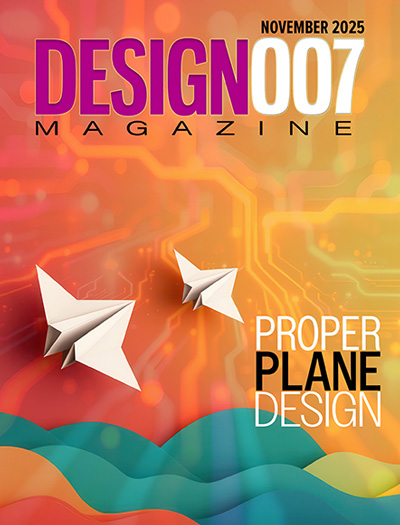-

-
News
News Highlights
- Books
Featured Books
- design007 Magazine
Latest Issues
Current Issue
Designing Proper Planes
Without planes, designers would have to create thousands of traces to accomplish the same objectives. Power planes provide low impedance and stable power, and ground planes stabilize reference voltage, improve thermal performance, and help preclude EMI issues.

Power Integrity
Current power demands are increasing, especially with AI, 5G, and EV chips. This month, our experts share “watt’s up” with power integrity, from planning and layout through measurement and manufacturing.

Signal Integrity
If you don’t have signal integrity problems now, you will eventually. This month, our expert contributors share a variety of SI techniques that can help designers avoid ground bounce, crosstalk, parasitic issues, and much more.
- Articles
- Columns
- Links
- Media kit
||| MENU - design007 Magazine
Changes on the Horizon: Is Resistance Futile?
February 10, 2022 | Stephen V. Chavez, PCEAEstimated reading time: 1 minute
For printed circuit engineers, especially those of us who have been in the industry for some time now, change is inevitable. From customer requirements that lead to design changes and deadlines being pulled in, to decreasing budgets and resource reallocations, change is one area where we must be adaptable if we want to survive and be successful in today’s industry.
Engineering change orders (ECOs), schematic/drawing redlines, component placement adjustments, and mechanical features modifications are among the changes that most of us usually deal with at one point or another during a project’s design cycle.
In my experience working for both small engineering firms and large OEMs, change typically translates into more time, which translates into more money. The big questions: Is the change billable or not? Who pays for this, or eats the cost of this change?
It all depends on how a contract was written, and how the purchase order (PO) was awarded. Potential changes are risk factors that are added into each quote, with a caveat that each change will be evaluated. This evaluation leads to a potential “out of scope” response to this change, adding an additional cost to the already agreed-upon PO, extension to the project schedule, or reset to the original project task duration. Every company handles purchase orders differently.
As I mentioned, change is inevitable in PCB design, and designers have become accustomed to it. But what about those other changes that may come at some point in our careers? Perhaps you’ve experienced a change in EDA tools, or a change in company culture, or both.
If so, you may have a special understanding of the famous motto of “The Collective” in Star Trek: Generations. “Resistance is futile.”
I feel your pain. Usually, this sort of change happens if you switch jobs, your company is acquired by another company, or your department is reorganized. It happens, and if it hasn’t happened to you yet, it probably will, if you remain in the industry long enough.
To read this entire article, which appeared in the February 2022 issue of Design007 Magazine, click here.
Testimonial
"The I-Connect007 team is outstanding—kind, responsive, and a true marketing partner. Their design team created fresh, eye-catching ads, and their editorial support polished our content to let our brand shine. Thank you all! "
Sweeney Ng - CEE PCBSuggested Items
What Emerging Circularity Policies Mean for the Electronics Industry
11/20/2025 | I-Connect007 Editorial TeamAs Europe accelerates toward a circular economy, electronics manufacturers face a wave of new sustainability requirements that will redefine product design, materials management, and end-of-life strategies. During a Nov. 11 webinar co-hosted by the Global Electronics Association and the Anthesis Group, industry leaders outlined the regulatory landscape shaping the next decade, including the Eco-design for Sustainable Products Regulation (ESPR), the Right to Repair (R2R) Directive, and the Extended Producer Responsibility (EPR) regulatory framework.
TTCI Receives 2025 Global Technology Award for Redefining Design for Testability in High-Reliability Electronics
11/20/2025 | TTCIThe Test Connection Inc. (TTCI), a trusted provider of electronic test and manufacturing solutions, has been awarded the 2025 Global Technology Award in the Test Services category for its groundbreaking work in Design for Testability (DFT).
Rubin’s Cableless Architecture and ASIC High-Layer HDI Designs Push PCBs to the Center of AI Compute Power
11/20/2025 | TrendForceTrendForce’s latest research points out that AI server design is undergoing a fundamental structural shift. From NVIDIA’s Rubin platform featuring a fully cableless architecture, to hyperscalers’ in-house ASIC servers adopting ultra-high-layer HDI designs, PCBs are no longer merely passive circuit carriers—they are becoming a core enabler of compute performance.
Accelerating the Global Commercialization of AR Waveguide Technology with AAC Technologies
11/19/2025 | Globe NewswireAAC Technologies Pte. Ltd., a world-leading smart device solution provider and a company incorporated in Singapore and a fully-owned subsidiary of AAC Technologies Holdings Inc., whose shares are listed and traded on the Hong Kong Stock Exchange, has signed a definitive agreement to acquire the shares and other equity securities in Dispelix Oy, a technology leader in diffractive waveguide displays for augmented reality (AR).
Flexible Circuit Technologies Welcomes Senior Applications Engineer Zack Schaner
11/18/2025 | Flexible Circuit TechnologiesFlexible Circuit Technologies a Minnesota-based flexible circuit and advanced electronics contract manufacturer, welcomes Zack Schaner as Senior Applications Engineer.


